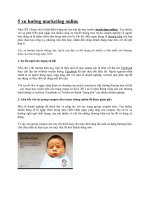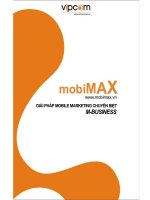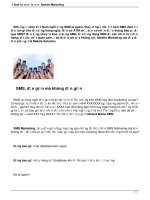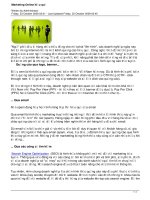mastering marketing
Bạn đang xem bản rút gọn của tài liệu. Xem và tải ngay bản đầy đủ của tài liệu tại đây (6.09 MB, 346 trang )
Mastering
Marketing
Second edition
Ian Ruskin-Brown
IFC
Second Edition
MASTERING MARKETING
A comprehensive introduction to the skills of
developing and defending your company’s revenue
Ian Ruskin-Brown
Published by Thorogood
10-12 Rivington Street
London EC2A 3DU
Telephone: 020 7749 4748
Fax: 020 7729 6110
Email:
Web: www.thorogoodpublishing.co.uk
© Ian Ruskin-Brown 2006
All rights reserved. No part of this
publication may be reproduced, stored in
a retrieval system or transmitted in any
form or by any means, electronic,
photocopying, recording or otherwise,
without the prior permission of
the publisher.
This book is sold subject to the condition
that it shall not, by way of trade or
otherwise, be lent, re-sold, hired out or
otherwise circulated without the
publisher’s prior consent in any form of
binding or cover other than in which it is
published and without a similar condition
including this condition being imposed
upon the subsequent purchaser.
No responsibility for loss occasioned to
any person acting or refraining from
action as a result of any material in this
publication can be accepted by the author
or publisher.
A CIP catalogue record for this book is
available from the British Library.
PB: ISBN 1 85418 323 0
ISBN 978-185418323-1
Cover and book designed by Driftdesign
Printed by Ashford Colour Press
Special discounts for bulk quantities
of Thorogood books are available to
corporations, institutions, associations
and other organizations. For more
information contact Thorogood by
telephone on 020 7749 4748, by fax on
020 7729 6110, or e-mail us:
The author
Ian Ruskin-Brown MSc. MIMgt. MCIM.
DipM. FInstSMM. MMRS.
Ian, formerly an academic, is now a practising and incurable author,
businessman and trainer. Over the last 30 years he has gained a wide
range and depth of experience in marketing and in management. He is
a full member of the Chartered Institute of Marketing, the Business
Graduates Association of MBAs, a fellow of the Institute of Sales and
Marketing Management, a full member and qualified as a Diplomat of
the Market Research Society, and a member of the British Institute of
Management.
Ian’s business career has a strong bias toward marketing management,
in the operational field and planning functions – including working for
companies such as J Lyons and Co., Reed Paper Group, Trebor Sharpes,
Esso Petroleum and Goodyear Tyre and Rubber.
Following a major motor accident in 1973, his career had oriented toward
the academic, and consultancy, working as a Senior Lecturer at the
SWRMC (now the University of the South West) and with visiting lectureships at the Universities of Bath, Bristol, Oran (Algeria) and the NIHE
Limerick (Eire).
For 13 years Ian was a member of the Faculty of the Chartered Institute
of Marketing (CIM), and was also recently a member of the IBM
International Business School. For these and other bodies, he has run
open and client-specific courses at home and abroad.
Ian has specialized in the service industries and has carried out much
in-house work, on a national and international basis, for a wide range
of companies.
Before taking up founding Directorships in several very successful companies, MSS Market Research Ltd and Mercator Ltd (MR Software), Ian
THE AUTHOR
iii
worked as an independent, freelance consultant, being involved in
consumer, industrial, Government policy and tourism projects, often
acting in the dual capacity of consultant/project leader.
In early 1983, Ian set up his own independent marketing consultancy,
now operating as Ruskin Brown Associates, for training in marketing
and sales skills and for the provision of both consultancy and market
research services. This activity continually brings him into contact with
a wide range of marketing situations at home and abroad.
iv
MASTERING MARKETING
Foreword
This book is designed to be read by practising business people, not
academics. It is often said that it is pointless to write for this audience
because although they may buy the books, they rarely read them. I believe
this behaviour (when it happens) is more a comment on the style of the
book, than on the predisposition of business people in general.
I am a market researcher by training and experience, having started
and helped to develop three very successful companies in that industry,
Mercator (producer of the world’s foremost data analysis software for
PCs), MSS Market Research, one of the UK’s leading full service agencies
and Marketing Decisions (now operating as Ruskin Brown Associates)
who specialize in helping their clients conduct or buy marketing
research more cost effectively.
By vocation I am a trainer and author of training material in marketing
topics, over the years having been a member of the faculties of the
University of the South West, IIRme (i.e. International Industrial
Research middle east), MCE (Management Centre Europe), The CIM
(i.e. The Chartered Institute of Marketing), IBM International Business
School (and their Marketing University – based in the USA), ICL,
CareerTrack International (with whom I worked with the Tom Peters
Organization), Management Centre Europe (MCE – part of the American
Management Association) Marcus Bohn Associates and Hawksmere to
name just a few.
Too many business books on marketing are either insultingly simplistic,
(such as those designed for the sole trader, available via Business Links
and the banks) or excruciatingly academic, obtuse, designed to impress
other academics, and/or as textbooks for those undergoing some form
of Higher Education. This book is different, I hope. As a practical and
comprehensive introduction to marketing, it is designed to be read by
those in business today. The particular audience in mind being those
without any formal marketing training who are responsible for the
defence and development of their company’s revenue (or who interface
FOREWORD
v
with such people in their company). It will appeal to entrepreneurs with
companies employing between 20 and 500 people. As well as those people
in larger companies who, through excelling in their technical areas, have
been promoted to areas of marketing responsibility, and need to
understand the concepts, practices and the language of this (to them
perhaps) new and alien discipline.
This book forms the hub of a wheel, the spokes of which examine in
more detail the skills and techniques of the individual disciplines that
go to make up the craft of marketing. Each one of these ‘spokes’ will
cover one specialism including:
•
marketing strategy and plans
•
marketing a service business
•
marketing communications
•
key account marketing
•
marketing research.
The sequence of the book is designed to take the reader logically through
the process of learning about the craft. From why marketing is important to the business, then, via a general overview of how marketing works,
to an examination of each of its main pillars:
•
choosing the company’s markets and customers
•
designing the right product
•
–
at the right price
–
promoting it the right way and
making it available to the customer in the right place at the right
time.
Mastering Marketing concludes with an introduction to the process of
understanding what the company is up against in its marketplaces, and
the techniques to gather this information.
Wherever pertinent, I illustrate much of the content with examples from
current real life businesses.
In nearly every chapter there are exercises to enable the reader to consolidate their understanding via application of the chapter contents to their
vi
MASTERING MARKETING
own business situation. I invite readers who may wish to check that they
are on the right lines when they address these exercises, to make contact
with me via e-mail, attaching their answers to the questions posed. I
would also welcome any other feedback, comments, questions or
constructive criticism that will help me improve this or subsequent books
in the series.
My e-mail address is:
or visit our website is www.ruskin-brownassociates.com
In the meantime, I wish you happy reading, and a very successful business.
Ian Ruskin-Brown
FOREWORD
vii
Icons
Throughout the Masters in Management series of books you will see
references and symbols in the margins. These are designed for ease of
use and quick reference directing you quickly to key features of the text.
The symbols used are:
Key Question
Guide to Best Practice
Action Checklist
Key Learning Point
Activity
Key Management Concept
We would encourage you to use this book as a workbook, writing notes
and comments in the margin as they occur. In this way we hope that
you will benefit from the practical guidance and advice which this book
provides.
viii
MASTERING MARKETING
Contents
CHAPTER ONE PART 1
The power of marketing – effectiveness is
more important than efficiency
2
Synopsis
2
Introduction
2
Strategic focus
3
Introducing the product life cycle (PLC)
5
Strategic focus and the product life cycle
9
Relative potency
10
The effectiveness/efficiency grid
13
Activity No. 1
18
CHAPTER ONE PART 2
The power of marketing – the law of supply and demand
22
Synopsis
22
Introduction
22
The basic link in the chain
23
Hard/sellers markets
24
Surviving oversupply
32
The marketing concept introduced
33
CHAPTER TWO
How marketing works
38
Synopsis
38
Introduction
38
Specific group of customers
40
Dialogue over time
49
Customer’s needs, understood in depth
52
CONTENTS
ix
Activity No. 2
57
The competitive differential advantage
58
How to develop competitive advantage
62
Activity No. 3
64
Marketing planning
65
CHAPTER THREE
Introducing the new marketing mix:
the marketing tools (the four or five P’s)
68
Introduction
68
Segmentation
70
Segment strategy approaches
73
How to segment
75
The process
76
Segmenting for services
82
Segmenting for an IT related market
83
Segmentation principles
87
Market selection (i.e. ‘targeting’)
87
How competitive will the company be in the new market?
89
Activity No. 4
93
Competitive product positioning
95
Activity No. 5
101
Exercise – your positioning
102
CHAPTER FOUR PART 1
The marketing mix – the ‘product’
x
104
What ‘products’ are
104
The total product concept
106
Activity No. 6
112
MASTERING MARKETING
CHAPTER FOUR PART 2
The marketing mix – distribution
– ‘Your route to market’
116
Introduction
116
Background
116
The environmental dimension
117
The structural dimension
117
Functions of the ‘route to market’
119
Using intermediaries: advantages and disadvantages
122
Managing the distribution channel
124
Power in the chain
127
Exercise
133
CHAPTER FOUR PART 3
The marketing mix – marketing communications
and promotion (marcomms)
136
Introduction
136
Understanding marketing communications
136
Public relations and editorial publicity (PR & EP)
139
The role of advertising and promotion
140
Activity No. 7
144
The campaign design process
146
Creative execution/treatment
162
Testing the execution
164
CHAPTER FOUR PART 4
The marketing mix – marketing pricing
168
Introduction
168
Internal accounting based pricing
168
Product life cycle and price
181
‘Value based’ pricing
185
Some useful marketing pricing strategies
189
Profit centre
194
CONTENTS
xi
CHAPTER FIVE
The marketing plan
Introduction
196
The plan as a working document
196
The plan as a learning process
197
The marketing programme
202
The plan’s main headings
213
The marketing audit
215
The action plan
216
The marketing programme
222
The control mechanisms
222
Building the budget
223
Action checklist
226
CHAPTER SIX
The marketing audit – deriving foundations
for a marketing strategy
xii
196
230
Synopsis
230
Introduction
231
The shock of change
233
Geography
235
Technological innovation – (the ‘T’ in G.p.l.e.e.s.t)
235
The structure of society – (the ‘S’ in G.P.l.e.e.s.t)
237
Political issues = government and legislation
241
The implications of cycles and change
243
Format for recording the macro analysis
243
Activity No. 8
246
Identifying the competition
246
Analyzing sales and marketing competency
253
Marketing assets and liabilities
259
Activity No. 9
265
A competitor’s company analysis checklist
265
MASTERING MARKETING
Activity No. 10
267
Our company analysis checklist
267
Specific to the competition
268
Activity No. 11
271
‘Good’ and ‘bad’ competitors
271
In summary
272
CHAPTER SEVEN
Getting the feedback
274
Synopsis
274
Introduction
274
Types of information
275
Secondary data via desk research
275
Primary information via field research
278
Qualitative research
280
Quantitative research
283
Market/customer information systems
284
The MIS/CIS tools
287
Market/ing research (some critical issues)
291
The research budget
295
The research brief
296
The proposal
299
APPENDIX
Workbook: Planning a campaign
307
I Objectives
308
II Strategies
310
Index
319
CONTENTS
xiii
List of illustrations
xiv
CHAPTER ONE PART 1
1.1: An organogram created from the company’s three options
3
1.2:
A stylized ‘PLC’
5
1.3:
Strategic focus – managing the product/s
9
1.4:
Relative potency
11
1.5:
Effectiveness – efficiency grid
14
CHAPTER ONE PART 2
1.6: The essential dynamic
23
1.7:
Law of supply and demand, pt1
26
1.8:
Creating competition
27
1.9:
Law of supply and demand, pt 2
28
1.10: Law of supply and demand, pt 3
29
1.11: Law of supply and demand, pt 4
31
1.12: Law of supply and demand, pt 5
32
CHAPTER TWO
2.1: Fictional organizational chart
49
2.2:
The marketing cycle
49
2.3:
Maslow’s hierarchy of needs
53
2.4:
Categorise your customers’ needs
58
2.5:
How do I compare versus the competition?
64
CHAPTER THREE
3.1: Segment variants
72
3.2:
Undifferentiated strategy
73
3.3:
Concentration strategy
74
3.4:
Differentiated strategy
75
MASTERING MARKETING
3.5:
Segmenting a market
76
3.6:
Technology adoption curve – as a psychographic
segmentation base
83
3.7a: Strategy for crossing the chasm
85
3.7b: Strategy for crossing the chasm
86
3.8:
A hypothetical positioning map
97
3.9:
Hypothetical spidergram positioning map
98
CHAPTER FOUR PART ONE
4.1: The Levitt Construct
106
CHAPTER FOUR PART TWO
4.2: A channel ‘push’ strategy
124
4.3:
A channel ‘pull’ strategy
124
4.4:
An orderly market – (to begin with)
131
4.5:
The ‘channel’ becomes the competition
132
CHAPTER FOUR PART THREE
4.6: The ‘D.A.G.M.A.R’ model
138
4.7:
Customer benefits – your company’s performance analysis 145
4.8:
Building a campaign
147
4.9:
The campaign’s foundation stones
148
4.10: Part of any business cycle or product life cycle
152
4.11: The target group
154
4.12: Defining the target group
155
4.13: The sequence
158
4.14: The campaign
166
CHAPTER FOUR PART FOUR
4.15: Simple break-even
171
4.16: Spreading the unspreadable (I)
172
4.17: Spreading the unspreadable (II)
172
4.18: Break-even for marginal pricing
174
4.19: Where the ratio of overhead to variable cost is high
176
LIST OF ILLUSTRATIONS
xv
xvi
4.20: Where the ratio of overhead to variable cost is low
177
4.21: Pricing strategy for high overheads/variable
cost ratios (e.g. for airliners and trainers)
178
4.22: Product life cycle showing investment and competition
181
4.23: Product life cycle showing a ‘skimming’ price
and effect on profit
183
4.24: Product life cycle showing the effect of a ‘barrier’ price
184
4.25: Perception of value
186
4.26: The principle of conjoint (trade-off) analysis
186
CHAPTER FIVE
5.1: The hierarchy of planning
198
5.2:
The hierarchy of planning
199
5.3:
The hierarchy of planning
200
5.4:
The programme formulation stage
200
5.5:
The context of strategy
201
5.6:
Outline marketing programme (or action plan)
203
5.7:
The marketing planning thought process
208
5.8:
The options when taking on the competition
209
5.9:
The headings of a marketing plan
214
5.10: The Ansoff Analysis Grid
217
5.11: After ‘Profitable Product Management’ R. Collier
225
CHAPTER SIX
6.1: The strategic triangle
232
6.2:
Technological innovation
235
6.3:
The structure of society
237
6.4:
Government – a major engine of change
241
6.5:
Analyzing segment macro environments
244
6.6:
Micro analysis
247
6.7:
Analyzing segment structural forces
249
6.8:
Rationale for SWOT analysis
250
MASTERING MARKETING
6.9:
Porter’s five competency factors analyzing
strengths and weaknesses
251
6.10: Company analysis checklist for strengths and weaknesses 258
6.11a: Marketing assets
260
6.11b: Marketing assets
262
6.11c: Marketing assets
263
6.12: A marketing assets and liabilities audit matrix
264
6.13: Assessing a competitor
269
6.14: ’Good‘ and ’bad‘ competitors
269
CHAPTER SEVEN
7.1: The information matrix
275
LIST OF ILLUSTRATIONS
xvii
Blank
CHAPTER ONE PART 1
The power of marketing –
effectiveness is more important
than efficiency
The power of marketing –
effectiveness is more important
than efficiency
Synopsis
The first part of this chapter examines the major ways in which a company
can improve its financial performance, how these ways break down into
various strategies and how these strategies are related to the stages of
the product life cycle.
It moves on to discuss which of the above strategies have the greatest
potency when it comes to making a contribution to financial performance. From this emerges the identification of effectiveness versus
efficiency, and then the potency of one versus the other when making
contributions to the company’s bottom line.
It goes on to establish that revenue generation is an order of magnitude more powerful than cost cutting, i.e. effectiveness is more potent
than efficiency. Finally, a small exercise is provided to help you assess
the effectiveness of your company.
Introduction
There are essentially four ways in which an organization can improve
its financial performance. Neither of these ways are mutually exclusive,
any one or combination of the four can be employed at any one time.
They are in no particular order of importance:
2
•
increasing sales volume
•
optimizing price
•
cutting costs
•
optimizing investment.
MASTERING MARKETING
Combining price and sales volume produces increased revenue. The
last option, optimizing investment, assumes that overall revenue and
profit are not affected, or at the very least remain static. Although the
first three are normally considered to be within the remit of an organization’s management, and the last (i.e.investment) the remit of the
board alone, it is interesting to note that although most management
have little, if any, direct control over the levels of investment in their
own organization, it is often the case that (particularly in business to
business situations) the sales and marketing teams can have an impact
on the levels of investment of their customers, via what they sell.
Although these four ways of improving financial performance can be
taken in any permutation or combination, the marketer must understand
how these impact on the strategy of the company. They must know in
what circumstances any particular combination is best employed, and
which of these strategies has the most potent impact on the bottom line.
Strategic focus
Improve
performance
Increase
revenue
Improve
profitability
Increase
sales volume
Improve
price
Expand
market
Increase
market share
Find new
users
Increase
usage
Find
new uses
Improve
price
Win
market
share
Reduce
costs
Buy
market
share
Prune
range
Prune
range
Prune
range
FIGURE 1.1: AN ORGANOGRAM CREATED FROM THE COMPANY’S THREE OPTIONS
THE POWER OF MARKETING
–
EFFECTIVENESS IS MORE IMPORTANT THAN EFFICIENCY
3
Addressing the three options which are within the remit of a company’s
management we obtain the cascade (or organogram) as shown in Figure
1.1.
We can see from this, that in order to increase sales volume we may
need to either expand our market place and/or increase our share of
that market place.
Expanding a market can mean creating new users, or alternatively
increasing the rates at which a company’s goods or service are used.
It could actually include promoting new uses entirely. For example, in
the mobile telephone industry, how much of the emphasis during the
first few years was to broaden the range of users of mobiles? Firstly,
to executive level business people, then management and then into the
general population. Within the general population the adult usage was
broadened, from adult males, through to adult females and latterly, into
teenagers in the family.
Increasing the usage rate of the mobile telephone was initially brought
about by lowering the cost of handsets and the subscriptions, and also
the cost of the call, and most recently by enabling people to pre-pay for
their calls. Examples of new uses for a mobile telephone are as:
•
a safety device for a woman alone at night
•
a means for parents to stay in touch with children
•
a tool for business travellers when abroad, to be able to make
contact with the home country.
New uses are constantly being evolved such as links with laptop
computers and then turning these into so-called PDAs (personal digital
assistants – mini laptops, still and video cameras etc) no doubt the evolution of mobile telephones will continue.
4
MASTERING MARKETING
Introducing the product life cycle (PLC)
Re-positioning
A
B
Profit
Cost
Volume
Conception Launch
Growth
Gestation Introduction
Saturation
Maturity
Decline
Time and stages
FIGURE 1.2: A STYLIZED ‘PLC’
The product life cycle (PLC) is a very useful framework for thinking about
the development of a company’s products in its markets. In this context
we will briefly examine the basic concept and its stages. After this, we
will see the implications of the PLC on what business strategies are open
to the company for improving the bottom-line in relation to where the
product is in its life cycle.
Gestation
This stage is the period between ‘conception’ and ‘launch’, during which
the ‘new product’ is being developed and its business future is being
planned. At this stage it is all investment so we see that the revenue line
is below the horizontal axis. Note, this condition applies well into the
THE POWER OF MARKETING
–
EFFECTIVENESS IS MORE IMPORTANT THAN EFFICIENCY
5









